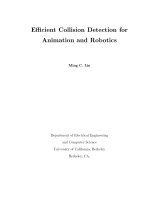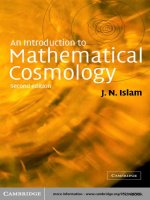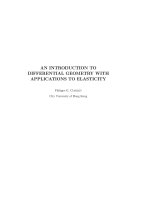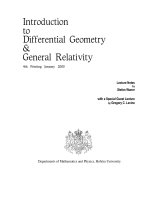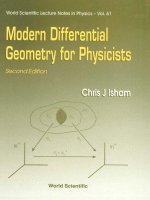- Trang chủ >>
- Khoa Học Tự Nhiên >>
- Vật lý
Modern differential geometry for physicists 2nd ed , c isham
Bạn đang xem bản rút gọn của tài liệu. Xem và tải ngay bản đầy đủ của tài liệu tại đây (14.85 MB, 306 trang )
Modern Differential
Geometry
for
Physicists
World Scientific Lecture Notes in Physics
Published
Vol.
47:
Some Elementary Gauge Theory Concepts
H
M
Chan and
S
T
Tsou
Vol.
48:
Electrodynamics of High Temperature Superconductors
A
M
Portis
Vol.
49:
Field Theory, Disorder and Simulations
G Parisi
Vol. 50: The Quark Structure of Matter
M Jacob
Vol. 51
:
Selected Topics on the General Properties
of
Quantum Field Theory
F
Strocchi
Vol. 52: Field Theory: A Path Integral Approach
A
Das
Vol.
53:
Introduction
to
Nonlinear Dynamics for Physicists
H
D
I
Abarbanel, et a/.
Vol.
54:
Introduction
to
the Theory of Spin Glasses and Neural Networks
V
Dotsenko
Vol.
55:
Lectures in Particle Physics
D Green
Vol.
56:
Chaos and Gauge Field Theory
T
S
Biro, et a/.
Vol.
57:
Foundations
of
Quantum Chromodynamics (2nd
edn.)
T
Muta
Vol.
59:
Lattice Gauge Theories: An Introduction (2nd edn.)
H
J
Rothe
Vol. 60: Massive Neutrinos in Physics and Astrophysics
R
N
Mohapatra and
P
B Pal
Vol.
61
:
Modern Differential Geometry for Physicists (2nd edn.)
C
J lsham
World
Scientific Lecture Notes in Physics
-
Vol.
61
Modern
Differential
Geometry
for Physicists
Second Edition
Chris
J
lsham
Theoretical Phvsics
Grow
Imperial College
of
Science, fechnolog
y
and Medicine
UK
World
Scientific
Singapore New Jersey. London Hong Kong
Published by
World Scientific Publishing Co. Re. Ltd.
P
0
Box
128, Farrer Road, Singapore 912805
USA once:
Suite
lB,
1060 Main Street, River Edge,
NJ
07661
UKoflce:
57 Shelton Street, Covent Garden, London WC2H 9HE
British Library
Cataloguing-in-Publication
Data
A
catalogue record for this book is available from the British Library.
First published 1999
Reprinted 2001
World Scientific Lecture Notes in Physics
-
Vol. 61
MODERN DIFFERENTIAL GEOMETRY FOR PHYSICISTS (2nd Edition)
Copyright
0
1999 by World Scientific Publishing Co. Re. Ltd.
All rights reserved. This book, or parts thereof; may not be reproduced in any form or by any means,
electronic or mechanical, including photocopying, recording or any information storage and retrieval
system now known or
to
be
invented, without wriften permission from the Publisher.
For
photocopying
of
material in this volume, please pay a copying fee through the Copyright
Clearance Center, Inc., 222 Rosewood Drive, Danvers,
MA
01923,
USA.
In this case permission to
photocopy is not required from the publisher.
ISBN
981-02-3555-0
ISBN 981-02-3562-3 (pbk)
This
book is printed on acid-free paper.
Printed in Singapore
by
UtcFPrint
Preface
This book is based on lecture notes for the introductory course on
modern, coordinate-free differential geometry which is taken by our
first-year theoretical physics PhD students, or by students attending
the one-year MSc course “Fundamental Fields and Forces”
at
Imperial
College.
The course is concerned entirely with the mathematics itself, al-
though the emphasis and detailed topics have been chosen with an
eye
on the way in which differential geometry
is
applied to theoretical
physics these days. Such applications include not only the traditional
area of general relativity, but also the theory of Yang-Mills fields, non-
linear sigma models, superstring theory, and other types of non-linear
field systems that feature in modern elementary particle theory and
quantum gravity.
The course is in four parts dealing with, respectively, (i) an intro-
duction to general topology; (ii) introductory coordinate-free differ-
ential geometry; (iii) geometrical aspects of the theory of Lie groups
and Lie group actions on manifolds; and (iv) the basic ideas of fibre
bundle theory.
The first chapter contains
a
short introduction to general topol-
ogy with the aim
of
providing the necessary prerequisites for the later
chapters on differential geometry and fibre bundle theory. The treat-
ment is
a
little idiosyncratic in
so
far
as
I wanted to emphasise certain
algebraic aspects of topology that are not normally mentioned in in-
troductory mathematics texts but which are of potential interest and
importance in the use
of
topology in theoretical physics.
V
vi
PREFACE
The second and third chapters contain an introduction to differ-
ential geometry proper. In preparing this part of the text,
I
was par-
ticularly conscious of the difficulty which physics graduate students
often experience when being exposed for the first time to the rather
abstract ideas
of
differential geometry. In particular,
I
have laid con-
siderable stress on the basic ideas of ‘tangent space structure’, which
I develop from several different points of view: some geometric, some
more algebraic. My experience in teaching this subject for
a
number
of years is that
a
firm understanding
of
the various ways of describing
tangent spaces
is
the key to attaining
a
grasp of differential geometry
that goes beyond just
a
superficial acquiescence in the jargon of the
subject.
I
have not included any material on Riemannian geometry
as
this aspect of the subject is well covered in many existing texts on
differential geometry and/or general relativity.
Chapter four is concerned with the theory
of
Lie groups, and the
action of Lie groups on differentiable manifolds. I have tried here to
emphasise the geometrical foundations of the connection between Lie
groups and Lie algebras, but the latter subject is not treated in any
detail and readers not familiar with this topic should supplement the
text at this point.
The theory of fibre bundles is introduced in chapter five, with
a
treatment that emphasises the theory of principle bundles and their
associated bundles. The final chapter contains an introduction to the
theory
of
connections and their use in Yang-Mills theory. This is
fairly brief since many excellent introductions to the subject aimed
at
physicists have been published in recent years, and there
is
no great
point in replicating that material in detail here.
The second edition
of
this book differs from the first mainly by
the addition of the chapter on general topology; it has also been com-
pletely reset in LaTeX, thus allowing
for
a
more extensive index. In
addition,
I
have taken the opportunity to correct misprints in the
original text, and
I
have included
a
few more worked examples.
A
number of short explanatory remarks have been added in places where
readers and students have suggested that
it
might be helpful:
I
am
most grateful to all those who drew my attention to such deficien-
cies in the original text. However,
I
have resisted the attention
to
PREFACE
vii
add substantial amounts
of
new material-other than the chapter on
topology-since I wanted to retain the flavour
of
the original
as
bona
fide lecture
notes
that could reasonably be read in their entirety by
a
student who sought an overall introduction to the subject.
Chris
Isham
Imperial College, June
1998
1
An Introduction to
Topology
1
1.1
Preliminary Remarks
1
1.1.1
Remarks on differential geometry
1
1.1.2
Remarks on topology
2
1.2
Metric Spaces
3
1.2.1
The simple idea
of
convergence
3
1.2.2
The idea
of
a
metric space
5
1.2.3
Examples
of
metric spaces
8
1.2.4
Operations on metrics
10
1.2.5
Some topological concepts in metric spaces
11
1.3
Partially Ordered Sets and Lattices
14
1.3.1
Partially ordered sets
14
1.3.2
Lattices
18
1.4
General Topology
23
1.4.1
An example
of
non-metric convergence
23
1.4.2
The idea
of
a
neighbourhood space
25
1.4.3
Topological spaces
32
1.4.5
A
topology
as
a
lattice
40
1.4.4
Some examples
of
topologies on
a
finite set
The lattice of topologies
T(X)
on
a
set
X
37
1.4.6 42
ix
X
CONTENTS
1.4.7
Some properties of convergence in
a
general topo-
logical space
45
1.4.8
The idea of
a
compact space
46
1.4.9
Maps between topological spaces
48
1.4.10
The idea
of
a
homeomorphism
51
1.4.11
Separation
axioms
52
1.4.12
Frames and locales
54
2
Differentiable Manifolds
59
2.1
Preliminary Remarks
59
2.2
The Main Definitions
60
2.2.1
Coordinate charts
60
2.2.2
Some examples of differentiable manifolds
64
2.2.3
Differentiable maps
68
2.3
Tangent Spaces
70
2.3.1
The intuitive idea
70
2.3.2
A
tangent vector
as
an equivalence class of curves
72
2.3.3
The vector space structure on
T,M
76
2.3.4
The push-forward of an equivalence class
of
curves
.
77
2.3.5
Tangent vectors
as
derivations
79
2.3.6
The tangent space
T,
V
of
a
vector space
V
90
2.3.7
A
simple example of the push-forward operation
91
2.3.8
The tangent space
of
a
product manifold
92
3
Vector Fields and
n-Forms
97
3.1
Vector Fields
97
3.1.1
The main definition
97
3.1.2
The vector field commutator
102
3.1.3
h-related vector fields
104
CONTENTS
xi
3.2 Integral Curves and Flows
107
3.2.1 Complete vector fields
107
3.2.2 One-parameter groups of diffeomorphisms
111
3.2.3 Local flows
115
3.2.4 Some concrete examples of integral curves and
flows
117
3.3
Cotangent Vectors
121
3.3.1 The algebraic dual of
a
vector space
121
3.3.2 The main definitions
123
3.3.3 The pull-back of a one-form
126
3.3.5 The Lie derivative
130
3.4
General
Tensors
and n-Forms
132
3.4.1 The tensor product operation
132
3.4.2 The idea of an n-form
135
The definition of the exterior derivative
137
3.4.4 The local nature of the exterior derivative
138
3.5 DeRham Cohomology
140
3.3.4
A
simple example
of
the pull-back operation
. .
129
3.4.3
4
Lie
Groups
149
4.1 The Basic Ideas
149
The first definitions
149
The orthogonal group
155
The Lie Algebra of
a
Lie
Group
157
4.2.1 Left-invariant vector fields
157
The exponential map
165
The Lie algebra of
GL(n,
IR)
169
4.3 Left-Invariant Forms
170
4.1.1
4.1.2
4.2
4.2.2 The completeness
of
a
left-invariant vector field 162
4.2.3
4.2.4
xii
CONTENTS
4.3.1 The basic definitions
170
4.3.2 The Cartan-Maurer form
172
4.4 Transformation Groups
175
4.4.1 The basic definitions
175
Different types of group action
179
Some important transitive actions
185
4.5 Infinitesimal Transformations
190
4.5.1 The induced vector field
190
The main result
195
4.4.2
4.4.3
4.4.4
The main theorem for transitive group actions
.
183
4.5.2
5
Fibre
Bundles
199
5.1 Bundles in General
199
5.1.1 Introduction
199
5.1.2 The definition of
a
bundle
201
5.1.3 The idea of
a
cross-section
207
5.1.4
Covering spaces and sheaves
210
5.1.5 The definition of
a
sub-bundle
213
5.1.6 Maps between bundles
214
5.1.7 The pull-back operation
216
5.1.8 Universal bundles
218
5.2 Principal Fibre Bundles
220
The main definition
220
5.2.2 Principal bundle maps
224
Cross-sections of
a
principal bundle
230
5.3 Associated Bundles
232
The main definition
232
5.3.2 Associated bundle maps
236
5.2.1
5.2.3
5.3.1
CONTENTS
xiii
5.3.3
Restricting and extending the structure group
.
240
5.3.4
Riemannian metrics
as
reductions
of
B(M)
.
.
243
5.3.5
Cross-sections
as
functions on the principle bun-
dle
246
5.4
Vector Bundles
248
5.4.1
The main definitions
248
5.4.2
Vector bundles
as
associated bundles
249
6
Connections in
a
Bundle
253
Connections in
a
Principal Bundle
253
6.1.1
The definition
of
a connection
253
6.1.2
Local representatives
of
a
connection
256
6.1.3
Local gauge transformations
258
6.1.4
Connections in the frame bundle
261
6.2
Parallel Transport
262
6.2.1
Parallel transport in
a
principal bundle
262
6.2.2
Parallel transport in an associated bundle
267
6.2.3
Covariant differentiation
269
6.2.4
The curvature two-form
271
6.1
BIBLIOGRAPHY
277
INDEX
281
1
An
Introduction
to
Topology
1.1
Preliminary Remarks
1.1.1
Remarks
on
differential geometry
A
physics student is likely to first encounter the subject
of
differential
geometry in
a
course on general relativity, where spacetime is repre-
sented mathematically by
a
four-dimensional differentiable manifold.
However, this is far from being the only use
of
differential geometry
in physics.
For
example, the Hamiltonian and Lagrangian approaches
to classical mechanics are best described in this way; and the use of
differential geometry in quantum field theory has increased steadily
in recent decades-for example, in canonical quantum gravity, su-
perstring theory, the non-linear a-model, topological quantum field
theory, and Yang-Mills theory.
Evidently, no excuse is needed for teaching
a
course on differential
geometry to postgraduate students
of
theoretical physics. However,
the impression of the subject gained from, say, an undergraduate
course in general relativity can be rather misleading when viewed
from the perspective of modern mathematics. Such courses usually
employ
a
very coordinate-based approach to the subject, with little
reference to the fact that more than one coordinate system may be
needed to cover
a
manifold. In particular, although there are usu-
ally copious discussions of the effects on tensorial objects
of
changing
1
2
CHAPTER
1.
AN INTRODUCTION TO TOPOLOGY
from one coordinate system to another, only rarely is it emphasised
that the domains of two coordinate systems may differ, and that-for
example-the familiar expression involving Jacobian transformations
is really only valid on the intersection of the domains of the coordinate
systems concerned.
What
is
neglected in such approaches to differential geometry is
the fact that the
topology
of
a
manifold may be different from that of
a
vector space, and hence-in particular-it cannot be covered by
a
single coordinate system. The modern approach to differential geom-
etry is very different: although coordinate systems have an important
role to play, the key concepts are developed in
a
way that is manifestly
independent of any specific reference to coordinates. Concomitantly,
the fact that
a
manifold
is
actually
a
special type of topological space
becomes of greater importance, and for this reason it is appropriate
to begin any text dealing with modern ‘coordinate-free’ differential
geometry with an introduction to general topology and associated
ideas. In fact, the subject of topology proper is of considerable signif-
icance in many areas of modern theoretical physics, and is well worth
studying in its own right.
1.1.2
Remarks
on
topology
The subject of topology can be approached in
a
variety of ways.
At
the most abstract level,
a
‘topology’ on
a
set
X
consists of a collec-
tion of subsets of X-known
as
the
open sets
of the topology-that
satisfy certain axioms (they are listed in Theorem
1.3).
This special
collection of subsets
is
then used to give
a
purely set-theoretic notion
of
characteristic topological ideas such
as
‘nearness’, ‘convergence of
a
sequence’, ‘continuity of
a
function’
etc.
From
a
physical perspective,
one could say that topology is concerned with the relation between
points and ‘regions’: in particular, open sets are what ‘real things’
can exist in.
Many excellent books on topology take an abstract approach from
the outset’. However, on
a
first encounter with the idea of
a
topology,
it
is
not obvious why that particular set of axioms is chosen rather
‘Two
classic
examples are Bourbaki (1966) and Kelly (1970).
1.2.
METRIC
SPACES
3
than any other, and the underlying motivation only slowly becomes
clear. For this reason, the particular introduction to general topology
given in Section
1.4
is aimed
at
motivating the axioms for topology
by starting with the broadest structure one can conceive with respect
to which the notion of
a
converging sequence makes sense, and then
to show how this definition is narrowed to give the standard axioms
for general topology.
Other texts take a somewhat different approach and motivate the
axioms for topology by starting first with
a
metric
space:
a
special
type of topological space whose underlying ideas are more intuitively
accessible than are those of topology in general. In addition, met-
ric spaces play many important roles in theoretical physics in their
own right; and for these reasons we shall begin with
a
short intro-
duction to the theory of such spaces. But it should be emphasised
that, in general, what follows cannot be regarded
as
a
comprehensive
introduction to topology, and it should be supplemented with private
study. The most I can do in the limited space available is to pro-
vide
a
quick introduction to some of the key ideas. However,
I
have
also included topics that
I
feel are of potential interest in theoretical
physics but which do not appear in the standard texts on topology:
a good example
is
the lattice structure on the set of all topologies
on
a
given set.
1.2
Metric
Spaces
1.2.1
The simple idea
of
convergence
A
key ingredient in any topological-type structure on a set
X
is the
sense in which
a
point’
x
E
X
can be said to be ‘near’ to another
point
y
E
X-without such
a
concept, the points in
X
are totally
disconnected from each other. In particular, we would like to say
that an infinite sequence
(51,
Q,
. .
.)
of points in
X
‘converges’ to
a
point
x
E
X
if
the elements of the sequence get arbitrarily near to
x
in an appropriate way. We shall use the idea of the convergence
of
’The notation
x
E
X
means that
x
is an element
of
the set
X.
4
CHAPTER
1.
AN INTRODUCTION TO TOPOLOGY
sequences to develop the theory
of
metric spaces and, in Section
1.4,
general topological spaces.
As
we shall see, in the latter case it is nec-
essary to extend the discussion to include the idea
of
the convergence
of
collections of
subsets
of
X-with this proviso, the structure
of
a
topological space is completely reflected by the convergent collections
that
it
admits.
A
familiar example is provided by the complex numbers: the ‘near-
ness’
of
one number
z1
to another
z2
is measured by the value
of
the
modulus
1
z1
-
z2
1,
and to say that the sequence
(z1,
z2,
.
.
.)
‘converges’
to
z
means that,
for
all real numbers
E
>
0,
there exists an integer
no
(which, in general, will depend on
E)
such that
n
>
no
implies
Izn
-
zl
<
E;
this is illustrated in Figure
1.1.
Thus the disks3
Figure
1.1
:
A
convergent sequence
of
complex numbers.
B,(z)
:=
{
z’
E
Q=
I
Iz
-
z’I
<
E}
‘trap’ the sequence. That is, the
3An equation of the form
cy
:=
p
means that the quantity denoted by
Q:
is
defined
by the expression,
p,
on the right hand side.
4The symbol
C
denotes the complex numbers.
5The notation
{z
I
P(z)}
means the set
of
all
2
such that the proposition
P(z)
is
true.
1.2.
METRIC
SPACES
5
convergence condition can be rewritten
as
“for
all
E
>
0
there exists
no
such that
n
>
no
implies
z,
E
BE(z)”
(1.2.1)
or,
in
terms
of
the
tails
T,
:=
{
zk
I
k
>
n}
of
the sequenceI6
“for
all
E
>
0
there exists
no
such that
Tn0
c
BE(z)”.
(1.2.2)
This notion of convergence can be generalized
at
once to the space7
IR”
of
all n-tuples
of
real numbers with the aid
of
the
distance func-
tion
d(Z]
y3
:=
d(Z
-
y3
.
(Z
-
y3
(1.2.3)
and the associated balls
Be(?)
:=
{
gE
IR”
I
d(Z,g)
<
E}.
(1.2.4)
Then
a
sequence
of
points
Zn
E
IR”
is
said to
converge
to
Z
E
R”
(denoted
Zn
+
Z)
if
‘Lfor
all
E
>
0
there exists
no
such that
n
>
no
implies
Zn
E
BE(Z)”.
(1.2.5)
1.2.2
The idea
of
a
metric space
The concept
of
a
distance function can be generalised to an arbitrary
set
X
by extracting the crucial properties
vis-a-vis
convergence
of
the
Euclidean distance
d(Z,y3
defined in Eq. (1.2.3). This gives rise to
the following definitions.
6The notation
A
c
B
means that
A
is
a
subset
of
B.
This does not exclude
the possibility that
A
=
B.
If
A
c
B
and
A
#
B
then
A
is said to be
a
proper
subset
of
B.
’The symbol
R
denotes the real numbers.
aThe symbol
Z
denotes the vector with components
(51,
52,.
.
. ,
sn);
a’.
b‘
de-
notes the usual ‘dot’ product
a’.
b‘
:=
C:=,
a&i.
6
CHAPTER
1.
AN INTRODUCTION TO TOPOLOGY
Definition
1.1
1.
A
metric on
a
set
X
is
a
mapg
lo
d
:
X
x
X
-+
lR
that satisfies
the three conditions
+,Y)
=
d(Y,z)
(1.2.6)
d(z,y)
2
0,
and
=
0
if, and only if,
z
=
y
(1.2.7)
d(z,
Y)
I
4x7
4
+
d(z,
Y)
(1.2.8)
for all
z,
y,
z
E
X.
The set
X
itself is said to be a metric space. Sometimes this
term is applied to the pair
(X,d)
if it is appropriate to make
a
reference to the specific metric function,
d,
involved.
2.
If Eq. (1.2.7) is replaced by the weaker condition
“d(z,y)
2
0,
with
d(z,z)
=
0
for all
z
E
X”
(ie.,
there may be
z
#
y
such
that
d(z,y)
=
0)
then
X
is said to be
a
pseudo-metric space,
and the function
d
is
a
pseudo-metric.
3.
As
in the example of the complex numbers, convergence of
a
sequence in
a
metric space can be defined in terms of the tails
of the sequence being trapped by the balls surrounding
a
point.
That is,
z,
+
z
means
“for all
E
>
0,
there exists
no
such that
Tn0
c
Bc(z)”,
(1.2.9)
where
B,(z)
:=
{
y
E
X
I
d(z,y)
<
E}.
Comments
1.
Any given sequence of points in
a
metric space
(X,
d)
may not
converge at all but, if it does,
it
converges to one point only [Exercise!].
In more general types of topological space,
a
sequence may converge
to more than one point (see later).
2.
It is important to know when two metrics can be regarded
as
being equivalent.
For
example, metrics
d(’)(z,
y)
and
d2)(z,
y)
on
a
gThe notation
f
:
A
-+
B
means that
f
is
a
function
(or
map) from the set
A
to the set
B.
We also write
a
e
f(a)
to denote that the particular element
a
in
A
is mapped to
f(a)
in
B.
“If
A
and
B
are sets,
A
x
B
denotes the Cartesian
product
of
A
with
B.
This
is defined to be the set of all (ordered) pairs
(a,
b)
where
a
E
A
and
b
E
B.
1.2.
METRIC SPACES
7
set
X
are said to be
isometric
if there exists
a
bijection
L
:
X
-+
X
such that, for all
z,y
E
X,
d(l)(z,y)
=
d2)(L(Z),
L(Y)).
(
1.2.10)
3.
Of greater interest perhaps is when two metrics lead to the same
set of convergent sequences, and with each sequence converging to the
same point in both metrics. This motivates the following definition:
Definition
1.2
1.
A
metric
d2)
is
stronger
than
a
metric
d(’)
(or
d(’)
is
weaker
than
d2))
if
“for all
II:
E
X,
for
all
E
>
0,
there exists
E’
>
0
such that
B!?(z)
c
Bil)(z)”.
(1.2.11)
2.
A
pair of metrics are
equivalent
if each one is stronger than the
other.
Comments
1. For any given pair
of
metrics on
a
set
X
it is not necessarily
the case that one is either stronger or weaker than the other.
2.
If the metric
d2)
is stronger than the metric
d(’)
in the sense
above, then the topology associated with
d2)
is stronger than that
associated with
d(’)
in the sense that it has ‘more’ open sets; see
Definition
1.11
for details.
3.
If
d2)
is stronger than
dl),
then
a
d2)-convergent sequence
is
automatically d(l)-convergent [Exercise!].
4.
It follows that equivalent metrics admit the same set of conver-
gent sequences.
A
result of considerable importance is the converse to this. Namely,
it can be shown that if two metrics induce the same set of convergent
sequences (with the same limits) then they are necessarily equivalent.
Some of the material needed to prove this will be introduced later.
0
8
CHAPTER
1.
AN INTRODUCTION TO TOPOLOGY
1.2.3
Examples of
metric
spaces
1.
If a differentiable manifold
C
is
equipped with
a
Riemannian metric
g,
the distance between
a
pair
of
points x,y
E
C
is defined to be
d(x,
y)
:=
inf
J
(saa(r(t))'r"(t)'ra(t))'
dt
(1.2.12)
Y
where the
infinurn
is over all piece-wise differentiable curves
t
+-+
y(t)
in
C
that
pass
through the points x and y.
2.
A
metric can be defined
on
any set
X
by
1
ifxfy
0
ifx=y.
d(z,y)
:=
3.
Some equivalent metrics on
IR"
are
(1.2.13)
d(Z,y3
:=
J(.'-$.(?-y3
(1.2.14)
d(.',q)
:=
max
1x2
-
yzl (1.2.15)
is1
n
P2
1. (1.2.16)
When
IR"
is viewed
as
a
topological space in this way,
I
shall refer
to
it
as
the
euclidean
space
Rn;
usually, this will also mean using the
particular metric Eq. (1.2.14).
Of course, the set of n-tuples
IR"
also has
a
natural vector space
structure:
if
it is desirable to emphasise this property, I shall refer to
the
vector
space
IR".
4. We recall that if
V
is
a
complex vector space,
a
norm
on
V
is
a
real-valued map
ii
H
11
ii
11
that satisfies the three conditions
(a)
~~i'+i?~~~~~ii~~
+
IIi?ll
for all
Z,CE
V
(1.2.17)
(b)
(1.2.18)
(c)
(1.2.19)
I)pi?ll=
1pl
11
611
for all
p
E
C
and
V'E
V
IIv'II>
0
with
IIi?ll=
0
only if
v'=
0.
1.2.
METRIC
SPACES
9
An example is
a
Hilbert space with
11
GI[:=
,/m
Note that Eq.
(1.2.14) is an example
of
this construction on the vector space
R”.
A norm gives rise
to
a
metric on
V
defined by
d(Z,
G)
:=[I
a
-
511
.
(1.2.20)
A
sequence of vectors that converges with respect to this metric is
said to be
strongly convergent.
5.
Spaces of functions play important roles in theoretical physics,
and
it
is
a
matter of considerable significance that many of these are
metric spaces. For example, let
C([a,
b],
R)
denote the space of all
real-valued, continuous functions on the closed interval
[a,
b]
:=
{
T
E
R
1
a
5
T
5
b
}.
A
metric can be defined on
C(
[a,
b],
R)
by
Another metric is
(1.2.22)
as sketched in Figure 1.2. This
is
inequivalent to the metric in Eq.
(1.2.21).
Another inequivalent metric is
(1.2.23)
6.
On any set
X,
let
[’(X)
denote the set
of
all real-valued func-
tions
f
on
X
such that
(i)
f(z)
=
0
for all but
a
countable set of
z
E
X;
(ii)
c~~~
(f(z))’
converges.
Then
a
distance function can be defined
on
f2(X)
by
(1.2.24)
10
CHAPTER
1.
AN INTRODUCTION
TO TOPOLOGY
Figure
1.2:
A
pair of functions satisfying
d(f,g)
:=
If@)
-
dt>l
<
E.
1.2.4
Operations on metrics
There are
a
number of ways in which metrics on
a
set
X
may be
combined to form
a
new metric. Some specific examples of such
op-
erations are
as
follows.
1.
If
di,
i
=
1,2,.
. .
,
n
is
a
finite set
of
metrics on
X
then
defines
a
metric on
X
if
{al,
u2,.
.
.
,
a,}
is any set of real numbers,
each of which
is
greater than or equal to zero and such that
at
least
one of them
is
non-zero.
2.
If dl and
d2
are
a
pair of metrics on
X,
a
new metric, called
the
join
of
dl
and
d2,
can be defined by, for all
s,
y
E
X,

